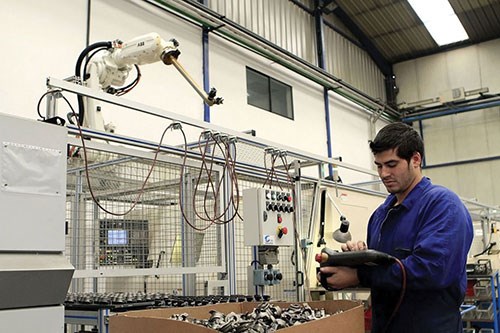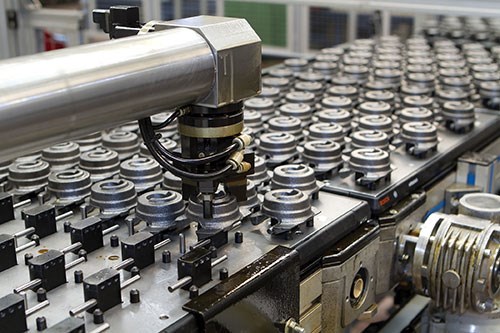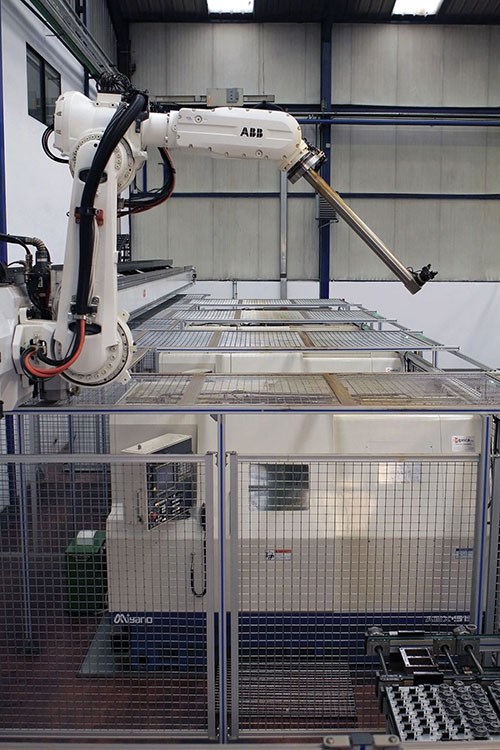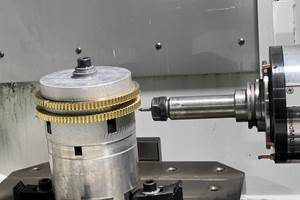Robots Increase Automotive Component Production
Auto parts manufacturer DAU Componentes in Burgos, Spain increases shop efficiencies by using robotics to automate loading and unloading of workpieces into CNC machines.
Share





Producing millions of parts every year is no small feat, but for automobile component manufacturer DAU Componentes of Burgos, Spain, that level of output was made possible by incorporating two robots from ABB (Auburn Hills, Mich.). Robotic automation has increased productivity and reduced cycle time.
Family owned and operated parent company Grupo Cropu was founded in 1975, specializing in surface treatments for the automobile industry and later expanding to offer similar treatments in other sectors. In 1994, the company founded DAU Componentes to produce brake pistons. Today, DAU’s 100-person workforce produces and exports 20 million parts worldwide each year, mostly in brake components and air conditioning compressor parts.
To meet these high output levels, the company needed to make sure its production process was as productive as possible. One task, in particular, fell short of this goal. Operators were manually loading “raw” workpieces into CNC machines, which was a slow and expensive process, as well as a poor use of operator time.
In January 2010, DAU decided to automate this task. After a detailed analysis of its manufacturing needs by TEMS, an engineering firm that was acquired by Grupo Cropu in 2007 and is now the group’s engineering division, the company selected two ABB IRB 6620LX robots. Each robot serves a line of four machines that cut the thread, polish the interiors and de-barb rough surfaces of the parts. The only manual part of the operation now is the first step—placing workpieces on trays.
In this case, the workpiece is a ball housing used in an automobile’s air conditioning system. Once the workpieces are on trays, a linear-axis, top-mounted robot picks up the raw workpiece and lifts it into the air, moving along the track to the CNC machines. The robot waits for the order to load from any of the four machines, and then top-loads the ball housing into the appropriate machine by precisely placing it on the chuck. With its job complete, the robot returns to its initial position to pick up the next piece.
This seemingly simple robotic solution has been a big success, says Isidoro Alfonso, Grupo Cropu’s industrial director. “We have eliminated the time it took for a manual operator to open the machine door, place the piece and close it again.”
Using the ABB robots, the company achieves a cycle time that is 3 percent shorter compared with manual loading. Also, thanks to the precision with which the piece is placed, the reject rate is lower. All told, productivity has increased by 4 percent. Using robots is also more ergonomic, and the fact that they are top-mounted provides great savings in terms of floor space.
However, Mr. Alfonso doesn’t measure the gains from the robots solely in such terms as increased productivity and reduced cycle times. “It’s all about quality,” he says. “Greater automation means better products for less cost. So, our competitiveness increases, and the company can hold its own against manufacturers in low-cost countries.” According to DAU, the return on investment for robotic automation is less than three years.
Related Content
3 Ways Artificial Intelligence Will Revolutionize Machine Shops
AI will become a tool to increase productivity in the same way that robotics has.
Read MoreFour-Axis Horizontal Machining Doubles Shop’s Productivity
Horizontal four-axis machining enabled McKenzie CNC to cut operations and cycle times for its high-mix, high-repeat work — more than doubling its throughput.
Read MoreCNC Machine Shop Honored for Automation, Machine Monitoring
From cobots to machine monitoring, this Top Shop honoree shows that machining technology is about more than the machine tool.
Read MoreLean Approach to Automated Machine Tending Delivers Quicker Paths to Success
Almost any shop can automate at least some of its production, even in low-volume, high-mix applications. The key to getting started is finding the simplest solutions that fit your requirements. It helps to work with an automation partner that understands your needs.
Read MoreRead Next
Registration Now Open for the Precision Machining Technology Show (PMTS) 2025
The precision machining industry’s premier event returns to Cleveland, OH, April 1-3.
Read MoreBuilding Out a Foundation for Student Machinists
Autodesk and Haas have teamed up to produce an introductory course for students that covers the basics of CAD, CAM and CNC while providing them with a portfolio part.
Read More5 Rules of Thumb for Buying CNC Machine Tools
Use these tips to carefully plan your machine tool purchases and to avoid regretting your decision later.
Read More







































